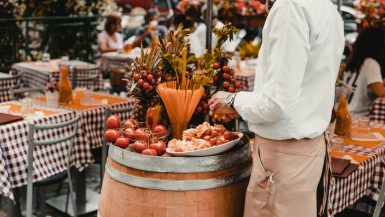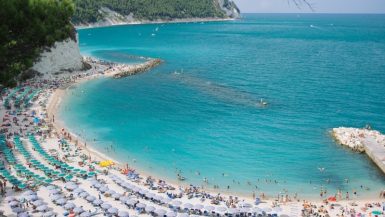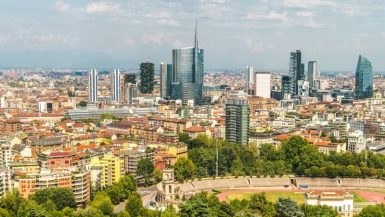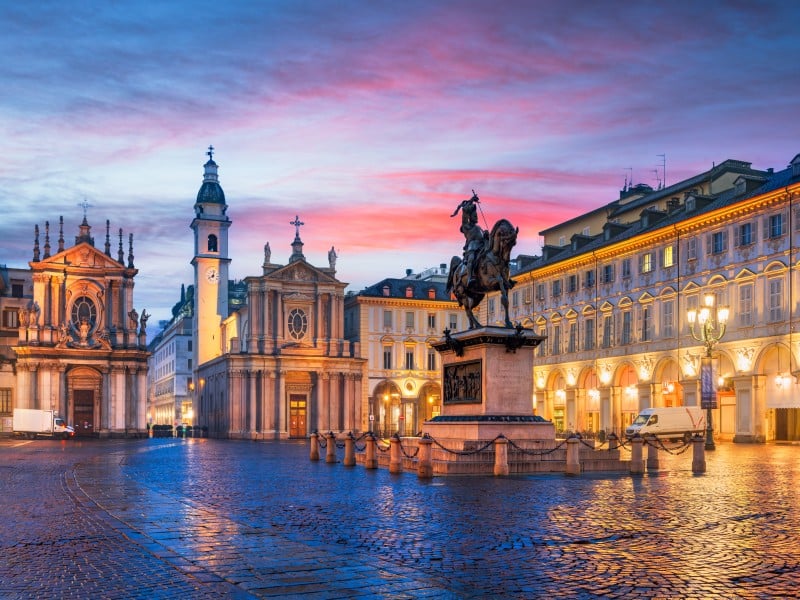
Located in northern Italy, close to the French border and the rugged Alps, Turin is a charming city with impressive architecture and a friendly local population. The city is often overlooked by foreign travelers in favor of bigger, more famous cities like Rome, Naples, and Florence, but is Turin worth visiting?
Turin was once the capital of Italy but now serves as the capital of Piedmont—the rich northwest region that gave the world Barolo wine and some of the creamiest mushroom risotto recipes you’ll ever taste. Still, on top of its dynamic food scene, Turin is also a city known for its grand piazzas, world-class museums, and dramatic setting.
It might not be the first place you think of when planning an Italian vacation, but Turin deserves a place on your list, and we’re here to show you why. Our guide looks at just 7 of the many reasons that make Turin worth visiting from the location to the cost. Let’s get into it.
The Underrated Vibe
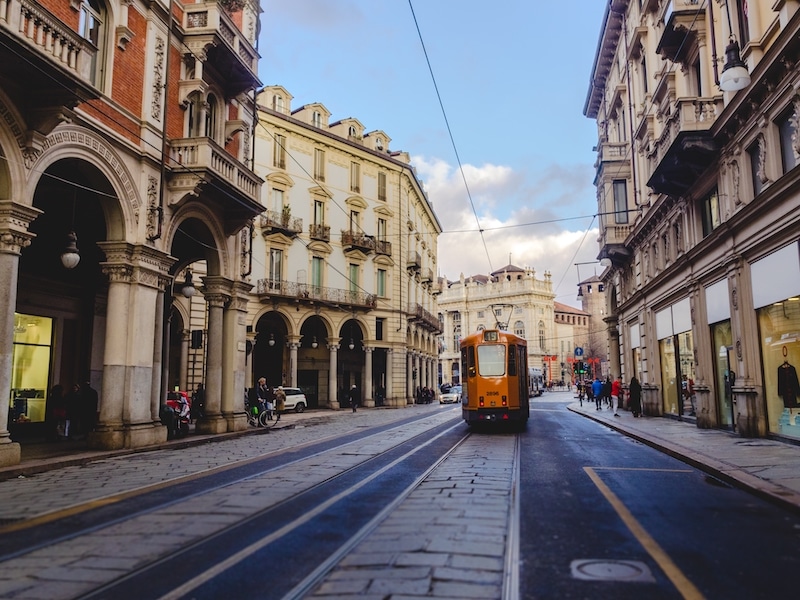
You might have never heard of this laidback and elegant city nestled in the northwest corner of Italy, but that’s one of the main reasons you need to visit. From the old-school tramways to the wide boulevards, Turin is like the Paris of Italy, but without the tourists.
Turin is a place to soak up real Italian life that you won’t find in busier, more fast-paced cities like Rome, Milan, and Venice. It’s true that the city is influenced by French and Swiss culture, but as the former modern capital of the country, Turin is Italian at heart.
Only around 300 thousand international tourists visited Turin in 2021, that’s less than half the population, compared to the more than five million people that visit Rome annually, far surpassing the population of less than three million. Turin is never crowded and has so much to offer in the way of authentic experiences.
You’ll find amazing sites, restaurants, and museums that locals love, as well as tons of greenery and open space with leafy piazzas, parks, and gardens, dotted around the city. The Pro River also runs through Turin and a refreshing aperitif in one of the many riverside cafes is always on the cards.
Few people speak fluent English so you might need to brush up on your Italian before visiting, but this only adds to the atmosphere. You’ll hear far fewer American and English accents in Turin than you’re used to. Turin is understated and underrated, but a true hidden gem in the north.
The Rich History
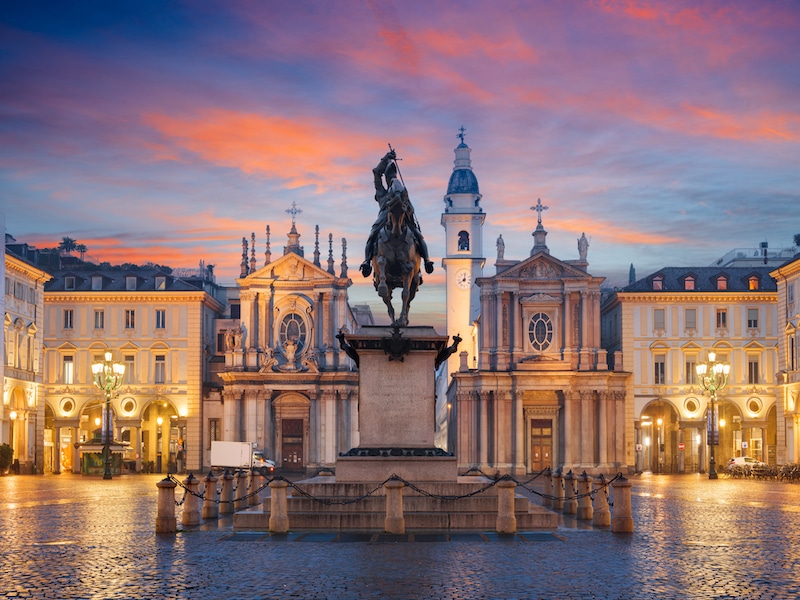
Turin has a rich and turbulent past. It might not be as obvious as Milan, but Turin has been an influential power for centuries and remains one of the most important business and cultural centers in northern Italy. Turin is certainly a city for history buffs and walking its streets you get a sense of all its changed hands.
The first settlements in Turin date back to pre-Roman times, when Taurisia, founded by Taurini, existed in place of the city. The town was destroyed by Hannibal, the Carthaginian invader, in 218 BC before it became a Roman military colony which was rebuilt by emperor Augustus and divided into 72 blocks. The remains of the walls, Palatine Gates, and Palatine Towers are still visible in Turin today.
After the fall of Rome, Turin was dominated by barbarians and became part of the Lombard Kingdom in the 300s, and then of the Frankish empire. Each culture has left its mark on Turin. When the Countess of Adelaide married Count Odo of Savoy in the 11th century in Turin, the city became linked to modern France.
Turin later became the capital of Savoy in 1559 when it was occupied by the French, but was besieged in 1640 and 1706 during the Spanish Succession. Although the French were defeated by Eugene of Savoy in 1706, they occupied Turin again during the Napoleanic Wars.
It was 1720 when Turin became the capital of the kingdom of Sardinia. Also known as the Kingdom of Savoy-Sardinia and Piedmont-Sardinia, this monarchy ruled the vast island and the northwest corner of Italy and was its own early modern country until the unification of Italy in 1861. In fact, Turin became the political and intellectual center for Risorgimento, the movement for the unification of the country. This led to Turin becoming the first modern capital of Italy from 1861 to 1865 before it was moved to Florence and then Rome another five years later.
Turin suffered heavy damage during World War II, but the city is still brimming with original features, buildings, palaces, and even ancient walls. Turin’s part in Italy’s years of power shifts is certainly a reason to visit and there’s a ton of evidence to stand for it around the city.
The Architecture

What better way to bear witness to Turin’s tempestuous past than through its grand architecture? Turin’s renowned buildings comprise an eclectic mix of styles and they tell the city’s story in their own words. Stately buildings rise up on the city’s boulevards, while historic cafes line the piazzas anchored by their Baroque palaces.
There’s not much left from the Roman period but the historical center of Turin, the “quadrilatero Romano”, still boasts the orthogonal street grid from Augustus’ improvements. There are also the remnants of a Roman amphitheater, located below the Royal Palace and occupying part of the cellars, which are thought to have been constructed between 13 BC and 44 AD.
Part of the ancient wall from this era stands in the Parco Archeologico in the center of Turin. The “Porta Palatina” is one of the four original gates of Roman Turin, and at 30 meters high it was an important defensive structure at the time. Turin was a crossroad for people traveling to and from the Alps and would’ve also been a place to stock up on food supplies and take rest.
There’s little left from Medieval Turin too, but the Cathedral of San Giovanni Battista is one late example. Built at the request of the bishop in the 1400s, it boasts a Renaissance facade with marble portals. Most other buildings from this time were destroyed or reinvented during the great urban renovation of Turin under the instruction of the Savoy Family.
Between the 17th and 18th centuries, the House of Savoy turned the small town of Turin into an important capital city using grand Baroque architecture to display wealth and assert power. They created a new street grid and refined the streets and piazzas to make them more elegant.
Architects like Guarino Guarini and Filippo Juvarra were invited to the city. Guarini built some of the most spectacular churches like the Church of San Lorenzo and the chapel of Sacra Sindone. Using interiors with multi-colored marble, pentagonal windows, and cross-arched domes, his style was exuberant and eye-catching. San Lorenzo is one of the finest examples of this.
Guarini also built Palazzo Carignano, best known for its unique undulating facade. Inside is an asymmetrical spiral staircase that bought visitors to the ballroom which is lit up from above through a glass ceiling. Today, the 17th-century palace houses the Museum of the Risorgimento (the unification of Italy).
Juvarra was responsible for some important renovations in Turin. He transformed the old medieval castle into a new royal residence, known as Palazzo Madama. The huge palace windows illuminate the grand staircase, and the building now contains the Museum Civico d’Arte Antica, which is Turin’s principal museum of ancient art.
The architectural highlights are endless, but other significant contributions from Juvarra include the hilltop Basilica of Superga that overlooks Turin and the Alps but is also meant to be seen by those approaching, as well as the royal palace of Venaria Reale, Palazzina di Stupinigi, and Villa Della Regina. All of these monuments are characterized by their stuccos and frescoes, high columns, big windows, and imposing statues.
The Museums
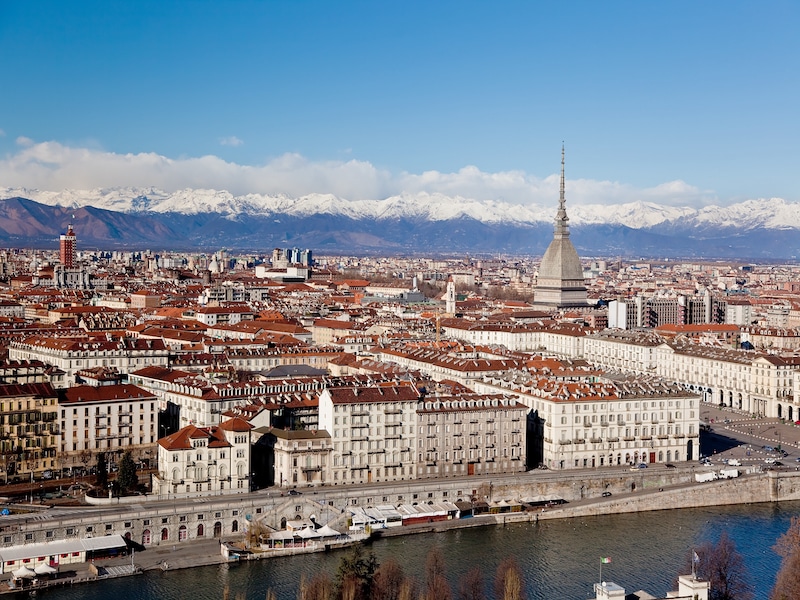
Once you’ve soaked up Turin’s past from walking through the historic streets, Turin’s museums are the best places to learn more about it. But it’s not all ancient rulers and royal palaces, Turin’s modern history is just as well-documented in its galleries.
The Mole Antonelliana is one of the major landmarks of Turin and a true emblem of the city and its skyline. Named after the architect, Alessandro Antonelli, it was initially conceived as a synagogue, but today it houses one of Turin’s most popular museums.
The National Museum of Cinema is operated by the Maria Adriana Prolo Foundation and contains a collection of work collected by the eponymous historian. The galleries celebrate Italian and international cinema, narrating the seventh art and offering an immersive and educational experience to its visitors. The peculiarity of the layout adds to the uniqueness of the exhibitions and it’s a must-see in the city.
The National Museum of Cinema is thought to be the tallest museum in the world, and also thanks to the towering neo-classical building in which it resides, it affords great panoramic views of the city.
The Museo Egizio is not only one of the best museums in Turin, but one of the highest regarded on the globe for its vast collection of ancient relics. With impressive exhibits and a multi-linguistic system, the museum is the second-best museum in the world dedicated to Egyptology and was founded in 1824, making it the oldest Egyptian museum too.
There are 12,000 exhibitions across the 2.5 kilometers of gallery space with artifacts, mummies, coffins, belongings, and even preserved food that used to be buried with the Egyptian kings. Besides archaeology and anthropology, the museum also explores natural history with a prehistoric and Roman section too.
And if you’re not into ancient history, the Museo Nazionale dell’Automobile might be more up your alley. Founded by Carlo Biscaretti di Ruffia, the rooms house almost 200 precious cars across eighty automobile brands, telling the story of the evolution of cars, engines, and car design in a way that will be fascinating even for non-car-lovers. The museum also has a dedicated exhibition to the development of the Ford Torino, the unique classic sports car that hails from the city.
The Food and Drink
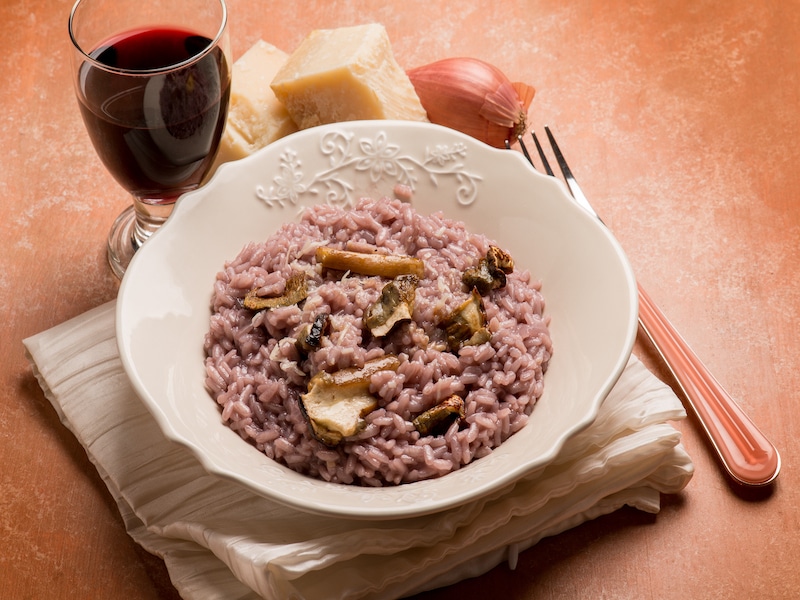
You can’t talk about Italy without mentioning the food, and Turin is no different. Piedmontese cuisine is tinged with French influence but also quintessentially Italian with its rich rice dishes, fresh pasta, and salty cheeses.
The Po Valley in Piedmont produces more rice than anywhere else in Italy, so it’s no surprise that risotto is also on the menu. Turin is responsible for some of the creamiest rice dishes infused with mushrooms and truffles foraged from the nearby Alpine woodlands. But Risotto Alla Barolo is one of the specialties of the city, as it involves the “kings of wines and the wine of kings” which hails exclusively from the verdant hills of Piedmont.
Barolo is considered to be one of the world’s very best wines, made from Nebbiolo, a small, thin-skinned red grape that’s acidic and tart in taste. Deliciously rich and deep, Barolo is an important part of the Turin food culture and is used to complement and infuse the gastronomy at any given chance.
Razza Piedmontese is the regional beef that’s loved all over Italy. In Turin, it’s classically braised in Barolo and garnished with thyme springs to warm on the coldest winter nights. Yet, it’s not all soul food. One of the exports that the Torinese hold most dear is their delectable chocolate truffles.
Thanks to the prized hazelnuts that hail from the forests of Alba, Turin has pioneered as makers of “gianduja”, the nutty milk chocolate that a plethora of artisanal chocolatiers turn into decadent souvenirs for visitors and daily snacks for locals in Turin. In fact, Pietro Ferrero, the world-class chocolatier, responsible for none other than Ferrero Rocher and Nutella spread, grew up in a town just outside of Turin. He transformed his family’s small pastry shop into a lucrative factory and went on to open shops all over the Piedmont capital.
Turin is also home to one of the largest food markets in Europe, the Mercat Centrale. From the wine to the rice to the truffles and Alpine cheese, there are tons of delectable delights that you must try in Turin and that make great souvenirs.
The Location
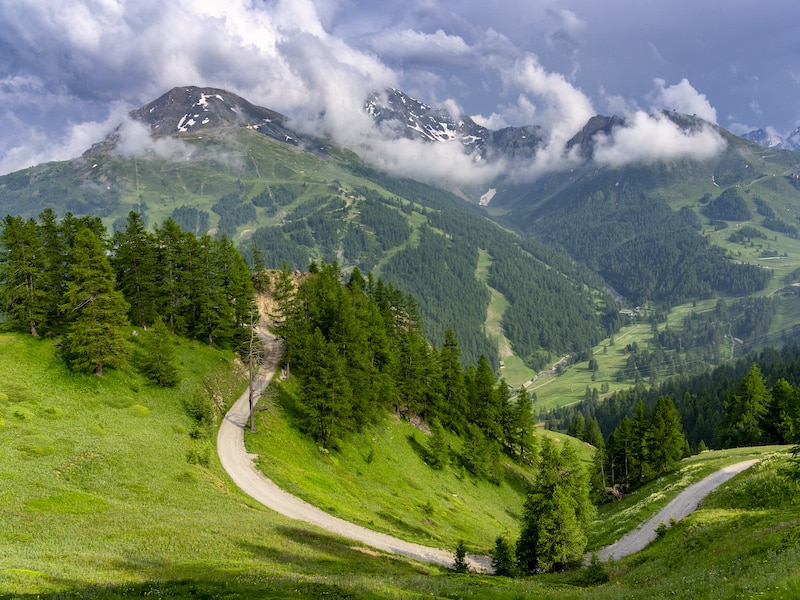
There’s so much to keep you busy in Turin, but the convenient location and magical setting are all the more reason to visit. For starters, the city is a melting pot of culture with French and Swiss influences visible all over the city. This is due to its position in the far west of northern Italy, but if you want more than just a taste of these elegant European cultures, the French and Swiss borders are closer to Turin than Milan.
Turin is a city that’s more readily compared to Grenoble than anywhere else in Italy, and this is unsurprising since it’s just a few hours away by car or train. In fact, Turin is well-connected to Europe and the rest of Italy, making it a convenient stop-off if you’re driving through the Alps or embarking on an interrailing adventure.
True, it’s further away from some of Italy’s most popular resorts in the south, but you could be in Milan in one hour, Genoa in two, Bologna in less than three, and Florence in three and a half hours by train. From Turin, you could even drive down to the Italian Rivera on the Ligurian Coast in just one hour and a half, and destinations in Switzerland like Geneva and Lausanne are reachable in a few hours with stop-overs in Milan or France.
This makes the potential for day trips from Turin neverending, but there’s also a lot in the immediate surroundings of the city that you can explore.
The Alps flank Turin and you’re ever-reminded of their presence by the spectacular views that rise up at different spots all over the city. The snow-capped peaks set the dramatic background to the city and are one of the most enchanting aspects of a trip to Turin. For hiking, you have the Susa Valley to the west of Turin and Aosta to the north where some of the highest peaks in Europe can be found.
There are also a number of top ski resorts in reach of Turin for some of Italy’s best pistes if you’re looking for a bit of adventure within your city break. Pregelato, Sauze d’Oulx, and Sestriere are just a few of these, offering national events, chalet resorts, and Olympic slopes. Whatever you’re after, Turin’s unique geography and position make for a different kind of Italian getaway.
The Cost
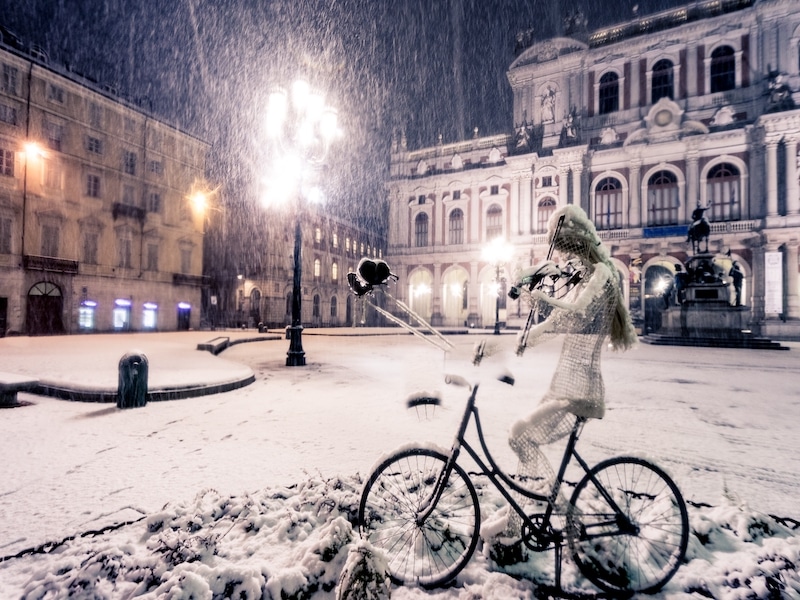
Finally, with all the elegance and sophistication on offer in Turin, its attractive prices should sinch the deal. Turin is Italy’s 4th largest city after Rome, Milan, and Naples—all notorious tourist hubs, and it bolsters a thriving cultural and business environment. Nevertheless, the cost of living is surprisingly low and as much as half the national average. Compared to Rome, rent prices are almost 40 percent lower.
For accommodation, there’s a wide selection of budget hotels and hostels, as well as mid-range lodgings, and more luxurious dwellings. Mid-range hotels average at €80 in the low season and closer to €125 when demand is higher. There are also plenty of vacation rentals in the city, starting from around €50 a night and averaging at €118 for a good, centrally located private home.
Even with all the decadent treats and famous produce, eating out won’t cost a fortune either. The average inexpensive meal costs around €13, while you can eat out for two at a mid-range restaurant for less than €60. A cappuccino in one of the many charming cafes won’t cost you more than €1.50 and a local bottle of wine from the Mercato could cost just €5, but expect to pay double if you want a cheap bottle of Barolo and closer to €30 to drink it in a restaurant. This is still less than you’d pay elsewhere in the world for much-loved wine.
If you’re planning to stick around, a one-bedroom apartment in the city center could cost you just €550 a month, or €1,200 for a three-bed. Head just outside the center and prices drop to €400 and just €800 a month for one and three beds respectively.
Getting around is cheap too with the rustic local transport comprised of extensive bus, tram, and metro routes. A one-way ticket is around €1.70 with a monthly pass starting from €38. For a city that exudes refinery, Turin sells the dolce vita at a discounted price.
How many days do you need in Turin?
To get around all the main sights, indulge in the local delicacies, and visit all the best museums, you need at least three days in Turin. However, we recommend five to seven if you want to wander into the surrounding regions and truly get a taste for the city.
Is Turin safe?
Turin is generally a very safe place with low crime rates and even lower incidents of violence. That said, you should still keep an eye out for pickpockets in busy areas. At night, the areas around the Porta Palazzo Market and Stazione Porta Nuova are best avoided if you’re walking alone.
When is the best time to visit Turin?
Turin is a year-round destination, but it gets much colder here in the winter than it does down south in Italy. If you’re an avid skier, this could be a draw factor, but for better weather, visit the city at the end of September. The summer crowds will have dissipated and the autumnal colors will be starting to come out. Fall also brings plenty of cultural events as well as the peak truffle season.
